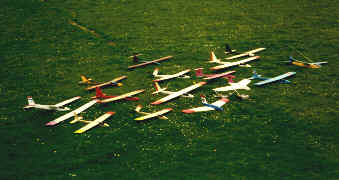The
Phoenix Range of Model Aircraft 
 The
Phoenix
Rangeof
model aircraft have been designed by Stan Yeo and are the culmination
of many years experience both as a modeller and an engineer. Stan
has enjoyed success at National and local level including RAFMAA.
He has also had a number of designs published and is a regular contributor
to the modelling press with articles on all aspects of model flying.An
aircraft engineer by profession and a qualified full sized glider
pilot. The
Phoenix
Rangeof
model aircraft have been designed by Stan Yeo and are the culmination
of many years experience both as a modeller and an engineer. Stan
has enjoyed success at National and local level including RAFMAA.
He has also had a number of designs published and is a regular contributor
to the modelling press with articles on all aspects of model flying.An
aircraft engineer by profession and a qualified full sized glider
pilot.
Stan
has a sound grasp of aerodynamics and believes it is better to make
a good job of something simple than a mediocre job of something
difficult. This and his unwillingness to compromise a design, or
the quality of materials, simply to cut costs are your guarantee
of satisfaction. The
following notes are designed to help you choose the model most suitable
for you. If you know which model interests you or just wish to browse
our selection simply click the navigation buttons in the left margin
of this page. To aid in your choice each model is categorised by
its potential performance. Category 1 models are suitable
for novice pilots i.e. modellers who have little or no experience
and those modellers who have only flown light wind rudder elevator
models on the slope. Category 6 & 7 models are
suitable for experienced pilots i.e. those that can fly competently
in most conditions.
If
you have limited slope flying experience and are looking to make
a quick transition to flying aileron models then it is recommended
that you build a rudder elevator model and purchase the aileron
wing kit. This way you hone your basic slope flying skills on a
rudder elevator trainer and for a minimum investment in time and
money convert to ailerons when the time is right. This is a cautious
approach but to be a good slope flyer in all conditions there are
certain aspects of slope flying that need to be instinctive such
as in-flight planning of manoeuvres and correct control inputs in
difficult situations. Aileron models are more responsive, less stable
and more manoeuvrable and are as a consequence more demanding to
fly. This means that the inexperienced pilot is put under a lot
more pressure and is unlikely to get the same enjoyment from flying
or make the same progress.
Once
you have graduated onto aileron models there are a number of Category
2/3 models to choose from. Each is slightly different in looks,
performance and, dare we say it, durability. If you are operating
from rough, rocky slopes and have limited experience then a conventional
or vee tail layout is recommended for repairability. All models
have viceless handling characteristics if built and set up as per
plan but some are quicker than others which means the 'thinking'
time is going to be shorter.
For
those that wish to graduate onto fully aerobatic models there are
a number to choose from. All feature a fully or near (Bedlam)
symmetrical section that is so essential for good inverted performance.
If do you decide to build a model with a symmetrical section please
remember that the model will require better lift conditions in order
to realise its full potential. Our recommendation is that a Category
2/3/4 model is also taken along to flying sessions so that should
the conditions not be ideal the second model can be flown. There
is no point in stooging around, trying to stay up, with a fully
aerobatic aeroplane if a semi-symmetrical sectioned model could
be flown more successfully.
The
fun category (Category 7) is reserved for small highly responsive
aerobatic models suitable for the more experienced flyer. An exception
to this is the (Wanabee) which
is as easy to fly as an aileron trainer. The reason these are classed
as fun models is due to their unique shape which could lead to model
orientation problems.
PS.
The above was written prior to the introduction of EPP (expanded
polypropylene) but nonetheless the classification system still applies.
|